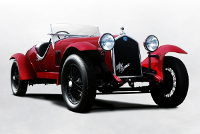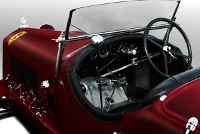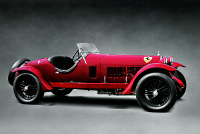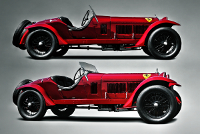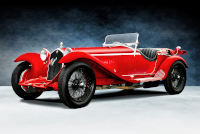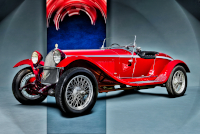Location:
Radnor Hunt Concours d'Elegance, 2007
Owner: Mark Gessler | Potomac, Maryland
Prologue:
This late 1500 cc fixed-head motor underscores how Alfa Romeo view the 6C as one continuous series across 1500 and 1750 cars. What we typically see is the Series III and Series IV 6C 1750, with a particular focus on the Gran Sport configuration. In this case, chassis #10814406 would appear to be a Series I car with an experimental motor, produced concurrently with the uprated 1750.
Add Scuderia Ferrari and racing driver Anna Maria Peduzzi to the equation, and the result is a Mille Miglia class win. Historical and technical significance combined in one chassis, I only regret my feeble visual survey in collecting this profile.
Reflecting on September, 2007, we enjoyed a nice day in the Pennsylvania Old Line countryside. My college roommate from Costa Rica stopped by and revelled in the sound of pre-War Italian race cars, and I began what would become an in-depth review of both Alfa Romeo and Pierce-Arrow. Was I creating great images at the time? No, not really. So it is a struggle to present a decent piece on this car. And yet I can't imagine the Alfa Romeo portfolio without it. For the people associated with this 6C Alfa (Ferrari, Peduzzi), for its significant production figures (the very last 6C 1500, one of six testa fissa motors), and for its Mille Miglia class win, chassis #10814406 is an unsung hero of historic race cars.
One particular benefit is that these older, lower-resolution shots can be combined and updated rather easily. And to be lenient with myself, these source images hail from the first concours at which I used a digital camera, (whereas I would continue to use film for landscape). Otherwise, this primitive approach yields scant visual material.
- - - - - - - - - -
► Image Source: Nikon D200 (10.2 MP)
References:
- Automobile Quarterly, Volume 7, Number 2, "Alfa Romeo 6C 1750" by Michael Lorrimer, The Kutztown Publishing Company, Inc., Kutztown, PA, page 200
- Alfa Romeo News: In, "Mille Magnifico," Mark Gessler recounts his entry in the 2010 Mille Miglia with chassis #10814406.
- Historic Racing: A worthwhile site, they offer biographies of many lesser-known racers, including Anna-Maria Peduzzi.
- Supercars.net: A worthwhile gallery that depicts numerous 6C 1500 examples, including #10814406, across Europe and on the modern Mille Miglia.
The Testa Fissa design gives the basic supercharged 6-cylinder an extra 8 horsepower, more or less, raising the total output to 90 brake horsepower, or thereabouts. Top speed doesn't really push beyond 90 miles per hour, but the average race speed for the winning Mille Miglia driver in 1930 is just 60 miles per hour. Through these early years, keeping a car alive means more than out-and-out speed. The roads are simply too rough, and the race too long for speed to rule all. In this sense, the Mille Miglia is very much a vestige of the original Grand Prix concept—a grueling endurance test on the open road.
After the War, Ferrari importer Luigi Chinetti brought chassis #10814406 into Colorado. The car had not been fully restored until Mark Gessler's effort. During restoration, film from the 1934 Mille Miglia contributed much information about the original state of things. Scuderia Ferrari badges identified the car, whereas the coachwork pointed to Zagato, but perhaps more accurately Brianza. Whichever of the two did actually clothe the car is partly insignificant. Brianza was a small concern run for only a few years by Ugo Zagato. So, apart from the badging, it is a historical difference rather than an artistic difference.
La Marocchina: Anna Maria Peduzzi and Scuderia Ferrari
Anna Maria Peduzzi, one of the classic era's most notable women drivers, purchased chassis #10814406. Nicknamed "Marocchina" for her complexion, she ran this 6C Alfa in no fewer than a half-dozen races in 1933, consistently placing well. In 1934, she drove for Scuderia Ferrari in the Mille Miglia, winning the 1500cc class with her husband, Gianfranco Comotti, riding alongside. Comotti also raced for Scuderia Ferrari, though he did not achieve much success beyond minor (non-Championship) Grand Prix following World War II. In contrast, Peduzzi's ability to compete at the forefront of the most arduous races of the classic era proves her strength as a racing driver.
Apart from taking a 1.5-litre class win in the 1934 Mille Miglia—a thousand mile loop from Brescia to Rome and back on rough public roads—she tackled the Targa Florio in Sicily on five occasions. In the post-War era, she continued racing for many years, despite physical impairment from the polio she suffered during the war years.
A point of frustration, perhaps, that women in the pre-War era such as Peduzzi gained enough respect so as to be selected by Enzo Ferrari to race for his Alfa Romeo team, whereas post-War society so quickly diminished the woman's role that we regressed in the equality race by some 50 years. Peduzzi's story is not unique. For all its terrible effects, World War II reset gender equality and civil rights in a strange and horrifically complete way. Not to say that pre-War society was correct or fair in its own right, but we seemed to deviate from a society that, by the classic era, called out differences but accepted ability at face value. War interrupted that gestating understanding of differences, and in the aftermath we restored primitive definitions of gender roles with consequentially tighter restrictions. We did so in deference to economic prosperity and a concept of rebuilding western life in some needlessly idyllic form.
One wonders what the shape of suffrage would be today had early 20th century trends not been interrupted. Peduzzi, for example, continued racing until 1961. She was one of the brightest stars in a class of women who built motorsport careers among countless others still who competed as amateurs. But chances for women to build for themselves a similar stature in the post-War era seemed narrow. The difference seems to be that, even as the classic era used prejudice against women, men seemed to still appreciate when women could do things—fly airplanes, for instance—and having proved that they could, women kept on doing. In the post-War era, the response tended to be "no" before any chance of doing could be proved.
Peduzzi's 1934 Mille Miglia class win is a noteworthy achievement for the car as well, as it occurred a long six years after a 1500cc Alfa won the race outright in 1928. Already by the end of 1930, Alfa Romeo had upgraded the 1500cc motor to 1750cc specification as a matter of course, along with a slightly revised chassis. However, 1.5 litre motors could still be had, if desired, until 1933. So it is that chassis #10814406—for all intents and purposes identical to any car of the four 1750 series—is the very last to be fitted with a 1500cc straight six. This car spells the end of an eight-year production run for the motor, during which time Alfa Romeo deployed more than 1,500 for road and race service. This particular motor, in addition to being the last ever fitted by the factory, is also one of twelve Testa Fissa specification motors—the head and block comprising one cast.
Motor: 1,487 cc straight 6-cylinder, iron block with fixed hemi-head in one casting | 62 mm x 82 mm
Valvetrain: DOHC, 2 valves per cylinder
Aspiration: Zenith 42 HA carburetor, Roots-type supercharger
Power: 76 bhp @ 4,800 rpm
Drivetrain: 4-speed gearbox, rear-wheel drive
Front Suspension: solid axle, semi-elliptic leaf springs, friction dampers
Rear Suspension: solid axle, semi-elliptic leaf springs, friction dampers
Architecture: pressed steel ladder-frame chassis with aluminum body by Zagato of Terrazzano di Rho, Lombardia
Kerb Weight: 845 kg (1,863 lbs)
Wheelbase: 2,920 mm (115 inches)
Top Speed: 140 km/h (about 87 mph)
Etymology:
'6C 1500' refers to the motor configuration, a straight 6-cylinder of about 1.5 litre displacement. 'Gran Sport' refers to the uprated tuning of these late model 6C cars, produced at a time when the 6C 1750 had already usurped the smaller capacity motor, adding hemispherical combustion and a roots supercharger to increase power. The term 'Testa Fissa' translates to 'fixed head,' which refers to the experimental measure of forming the block and head in a single cast. Zagato is the Milanese coachbuilder who provided the aluminum coachwork, (or possibly Brianza, though the difference in this case is academic). Note that the car wears a Scuderia Ferrari badge on the nose. Enzo Ferrari signed Anna Maria Peduzzi to compete in the 1934 Mille Miglia, one of his first Scuderia Ferrari competitors. She won her class.
Figures:
Alfa Romeo built more than 1,500 examples of the 6C 1500, mostly from 1926 to 1929. These cars form Series 1 and Series 2 of the 6C program. Series 3 through 6 are 6C 1750 cars. A 1500 cc Alfa Romeo built in 1933 is therefore something of an afterthought, an experiment to test the fixed-head design. So it isn't surprising that chassis #10814406 is the last car fitted with the 6C 1500 motor. Alfa Romeo produced a scant twelve of these fixed head rarities, six of 1500 cc displacement and six of the 1750 cc.
Zagato-Brianza: Details of the 6C Zagato Theme
The evocation pictured here exhibits numerous cues of late series 6C 1750 cars. The rectangular footwell vent on the flank, cut-down doors, and short, swept-back tail all look like standard Zagato cues. And yet the extra length in the chassis also makes this 1.5 litre car lower and meaner looking than its 1.75 litre cousins. The car wears small Zagato badges on the base of its doors.
The refabricated body on chassis #10814406 looks lower, longer, and faster than most 6C 1750 cars, its proportions foreshadowing the long-chassis 8C 2300 more than the third series 6C spiders that replaced the aging 1.5 litre series. The body displays a fuselage curvature across the top, chrome free, with a tail that gently ducks inward of the stylized fenders. The doors, too, are very deeply curved, with a dovetail treatment to the hinges that most 6C cars lack.
Flared Fenders: Late Model 6C Curves
A bit more than simple cycle fenders, the running gear on this 6C Alfa looks more mature than on earlier attempts. Flat paneling gives way to more complex forms, with smooth flares that would do alright to catch the dash off the road surface, but also save weight for cutting out the running board in between.
Last Updated: Mar 26, 2025

